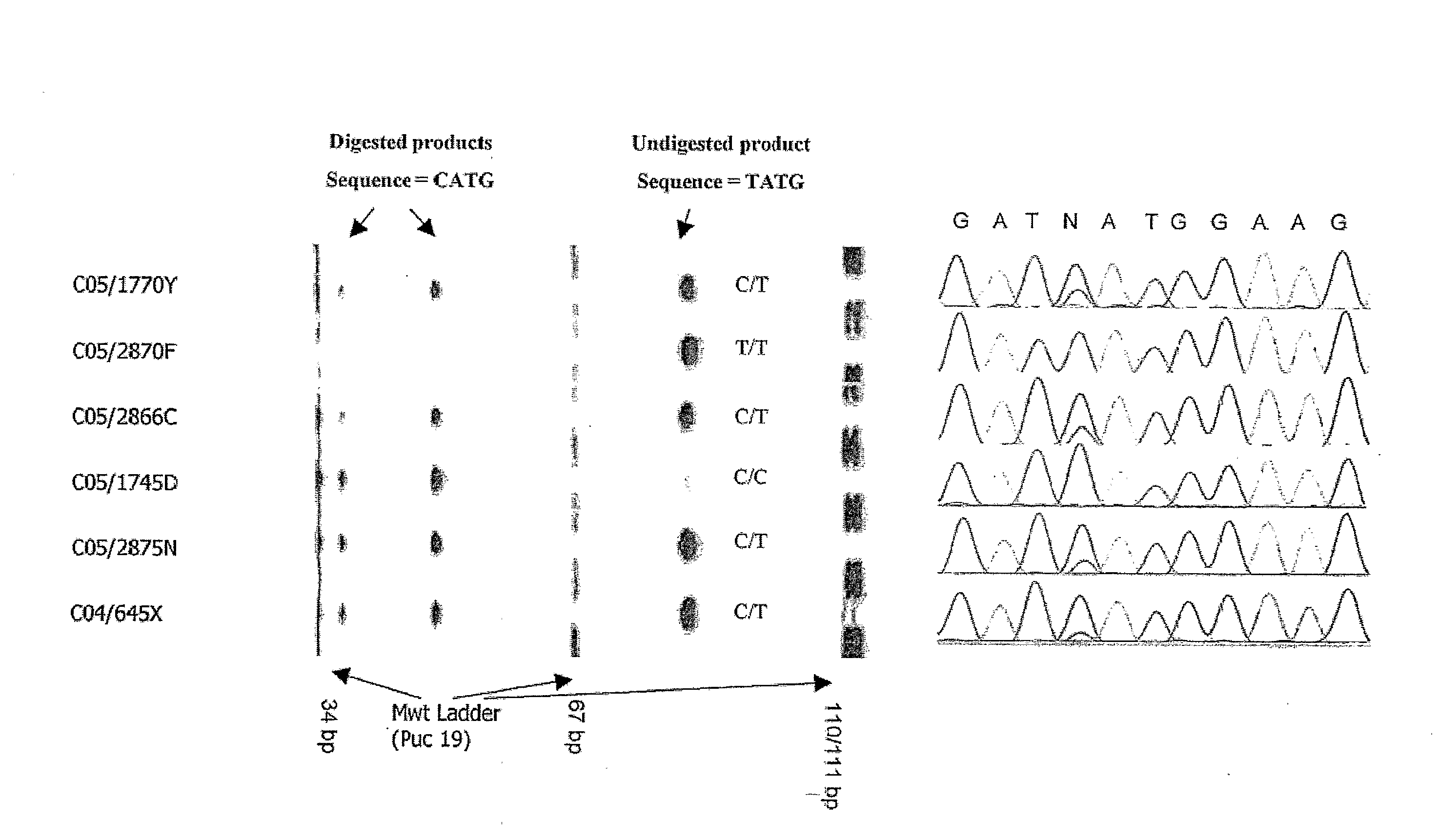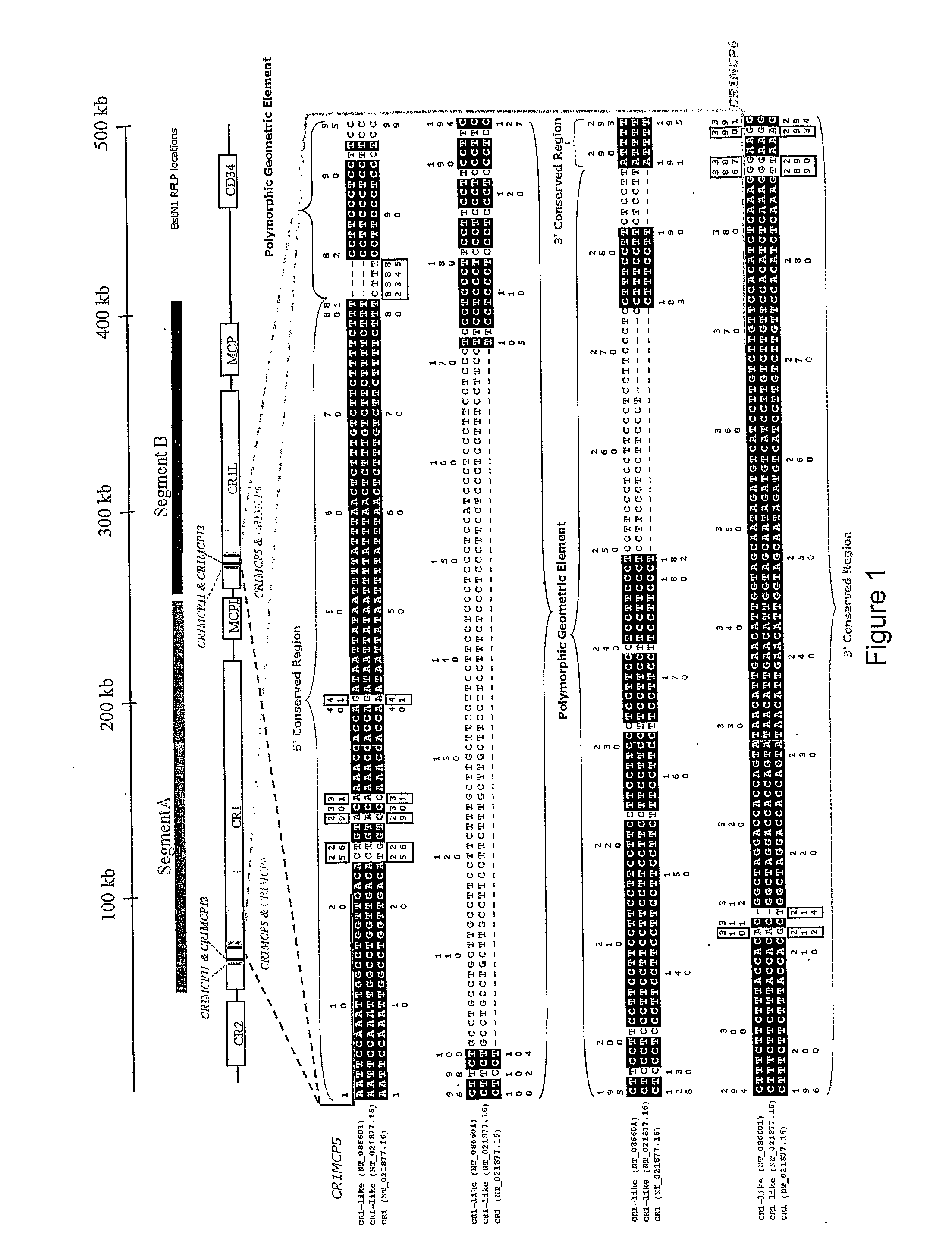Identification of ancestral haplotypes and uses thereof
a technology of ancestral haplotypes and haplotypes, applied in the field of ancestral haplotype identification, can solve problems such as unevenness in the genome, and achieve the effect of increasing the risk of age-related macular degeneration in individuals
- Summary
- Abstract
- Description
- Claims
- Application Information
AI Technical Summary
Benefits of technology
Problems solved by technology
Method used
Image
Examples
example 1
Identification of Haplospecific Geometric Elements in Duplicated Genes Encoding Complement Control Proteins
Methods
Identification of Duplicons
[0184]The genomic region containing CR1, MCP-like, CR1-like and MCP at 1q32, was taken from the NCBI database (http: / / www.ncbi.nlm.nih.gov / ) (position 1124945-1449694 on contig NT—021877.16 (gi:37539616); accession numbers AL691452.10, AL137789.11, AL365178.10 and AL035209.1). This sequence was compared against itself using Dotter (Sonnhammer and Durbin, 1995) to identify evidence of duplication (McLure et al. 2005a).
Selection of Primer Sites Present in all Duplicons
[0185]Segment A, containing CR1 and MCP-like was compared to Segment B, containing CR1-like and MCP. Regions within these two segments which shared a complex geometric element were identified as targets (McLure et al. 2005a). The geometric element must vary in size between the duplicates (see FIGS. 1 and 2) but also contain enough homology either side of the element so as to enable ...
example 2
Identification of Ancestral Haplotypes Significantly Decreased in Indian Samples from RSA Patients
[0213]Regression analyses was performed using WinBugs (V1.4.1 http: / / www.mrc-bsu.cam.ac.uk / bugs / winbugs / contents.shtml) which uses Bayesian MCMC methods to estimate empirical 95% credible intervals (CI), which are less biased for small sample sizes. The odds ratio is significant with a p-value <0.05 if these 95% credible intervals do not include 1. The analyses were performed with the assistance of an Excel-Winbugs interface Add-in BugsXLA (v2.1, Phil Woodward http: / / www.pipshome.freeserve.co.uk / stats / ). As is customary when there are zero cell counts, a constant of 0.5 was added to all cells counts as odds ratios are not defined in these instances.
[0214]Indian samples (RSA samples pooled) were compared to Caucasian samples (pooled over 5 groups). The results are provided in Table 3.
[0215]A number of the AH's are significantly decreased in Indian samples compared to Caucasians.
example 3
CR1 Haplotype Analysis of Recurrent Spontaneous Abortion Patients
[0216]Analysis was performed as described above in relation to Example 2. The results are provided in Table 4.
TABLE 3Indian samples (RSA samples pooled)were compared to Caucasian samples.GMT TYPINGINDIANS vs CAUCASIANSP5 + 6P11 + 12HaplotypeOdds Ratio (95% CI)5.01.13H10.28 (0.17, 0.46)4.01.13H20.15 (0.07, 0.31)5.161.15H30.31 (0.16, 0.57)5.131.11H40.94 (0.24, 3.53)6.04.13H50.54 (0.19, 1.45)5.141.15H60.01 (0.00, 0.24)5.171.15H70.01 (0.00, 0.22)6.135.11H81.17 (0.42, 3.28)5.151.15H90.09 (0.01, 0.46)6.01.13H100.30 (0.03, 2.05)6.94.17H110.14 (0.01, 0.74)4.01.12H120.02 (0.00, 0.43)5.01.19H130.39 (0.07, 1.74)5.01.18H141.18 (0.29, 4.93)4.141.11H150.47 (0.08, 2.22)OtherOtherOther1pexact = 0.000002
TABLE 4Analysis of recurrent spontaneous abortion patients(RSA-P) compared with a control group (RSA-C)GMT TYPINGRSA-P vs RSA-CP5 + 6P11 + 12HaplotypeOdds Ratio (95% CI)5.01.13H10.91 (0.40, 2.06)4.01.13H20.08 (0.01, 0.47)5.161.15H30.64 ...
PUM
| Property | Measurement | Unit |
|---|---|---|
| temperature | aaaaa | aaaaa |
| ionic strength | aaaaa | aaaaa |
| pH | aaaaa | aaaaa |
Abstract
Description
Claims
Application Information
 Login to View More
Login to View More - R&D
- Intellectual Property
- Life Sciences
- Materials
- Tech Scout
- Unparalleled Data Quality
- Higher Quality Content
- 60% Fewer Hallucinations
Browse by: Latest US Patents, China's latest patents, Technical Efficacy Thesaurus, Application Domain, Technology Topic, Popular Technical Reports.
© 2025 PatSnap. All rights reserved.Legal|Privacy policy|Modern Slavery Act Transparency Statement|Sitemap|About US| Contact US: help@patsnap.com



